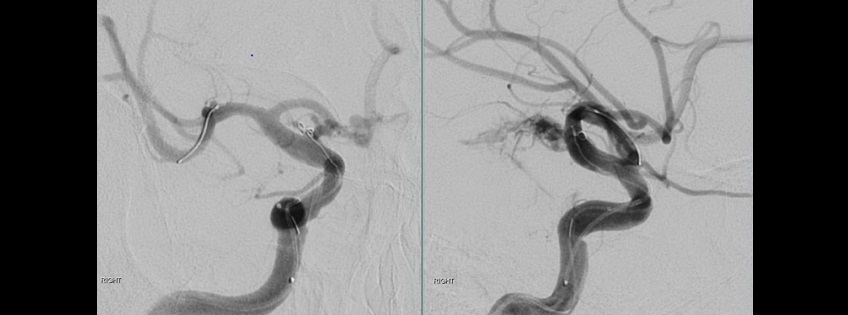The worst outcomes occur when IPR induced by microcatheter results in hemorrhage, researchers caution.

Both small dome size and location in the anterior communicating artery are risk factors for intraprocedural rupture (IPR) of aneurysms during coil embolization, according to a retrospective analysis published online recently in the Journal of NeuroInterventional Surgery. Every effort should be made to avoid this complication, the study authors advise, because it can be devastating.
Lead author Shuhei Kawabata, MD (Kobe City Medical Center, General Hospital, Kobe, Japan), told Neurovascular Exchange that intraprocedural rupture is rare enough that many neurointerventionalists have never experienced it. “This study was the largest to date [to identify] risk factors for IPR,” he said via email.
Kawabata and colleagues retrospectively evaluated the medical records and radiologic data of 1,375 patients with 1,406 unruptured intracranial aneurysms who underwent coil embolization at their center between January 2001 and October 2016.
Overall, intraprocedural rupture occurred in 20 aneurysms of 20 patients (1.4%). Univariate analysis revealed that rupture was more likely to occur in aneurysms with a small dome size and in those that were located in the anterior communicating artery. They were also more likely to occur in patients with a medical history of dyslipidemia.
Multivariate analyses revealed that independent predictors of intraprocedural rupture were small dome size and location in the anterior communicating artery. Dyslipidemia was no longer predictive of IPR.
Independent Predictors of Intraprocedural Rupture
|
|
OR (95% CI) |
P Value |
|
Dome Size < 5 mm |
3.43 (1.35 to 9.00) |
0.0096 |
|
Anterior Communicating Artery vs Other Location |
7.54 (2.82 to 19.30) |
0.0001 |
Overall, 57% of intraprocedural ruptures induced by a microcatheter were associated with severe subarachnoid hemorrhage. None of the ruptures associated with other causes resulted in this outcome.
Kawabata highlighted the importance making every effort to avoid hemorrhage caused by microcatheter in particular. “Once IPR occurs, we should manage it appropriately to control bleeding, thromboembolic complication, and acute hydrocephalus,” he added.
Overall, the mortality rate from IPR was 0.15% and the morbidity rate was 0.22%. Thromboembolic complications occurred in seven patients (35%) who experienced IPR. In addition, six patients (30%) with IPR required external ventricular drainage placement after developing symptoms of acute hydrocephalus.
Kawabata pointed out that while the rate of intraprocedural rupture is quite low, among patients who developed it, the morbidity and mortality rates were 15% and 10%, respectively. “This is why IPR is one of the most feared complications of endovascular treatment,” he explained.
Special attention should be paid when treating aneurysms with small dome size or located in the anterior communicating artery, Kawabata advised, adding, “And we should also take clipping surgery into consideration in some cases.”
Source:
Kawabata S, Imamura H, Adachi H, et al. Risk factors for and outcomes of intraprocedural rupture during endovascular treatment of unruptured intracranial aneurysms. J NeuroInterv Surg. 2017;Epub ahead of print.
Disclosures:
Kawabata reports no relevant conflicts of interest.

